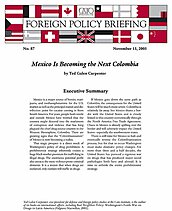Mexico is a major source of heroin, marijuana, and methamphetamine for the U.S. market as well as the principal transit and distribution point for cocaine coming in from South America. For years, people both inside and outside Mexico have worried that the country might descend into the maelstrom of corruption and violence that has long plagued the chief drug-source country in the Western Hemisphere, Colombia. There are growing signs that the “Colombianization” of Mexico is now becoming a reality.
That tragic prospect is a direct result of Washington’s policy of drug prohibition. A prohibitionist strategy inherently creates a huge black-market premium for trafficking in illegal drugs. The enormous potential profit also attracts the most violence-prone criminal elements. It is a truism that when drugs are outlawed, only outlaws will traffic in drugs.
If Mexico goes down the same path as Colombia, the consequences for the United States will be much more severe. Colombia is relatively far away, but Mexico shares a border with the United States and is closely linked to this country economically through the North America Free Trade Agreement. Chaos in Mexico is already spilling over the border and will adversely impact the United States—especially the southwestern states.
There is still time for Mexico to halt and eventually reverse the Colombianization process, but for that to occur Washington must make dramatic policy changes. For more than three and a half decades, the United States has pursued a vigorous war on drugs that has produced major social pathologies both here and abroad. It is time to rethink the entire prohibitionist strategy.

This work is licensed under a Creative Commons Attribution-NonCommercial-ShareAlike 4.0 International License.

